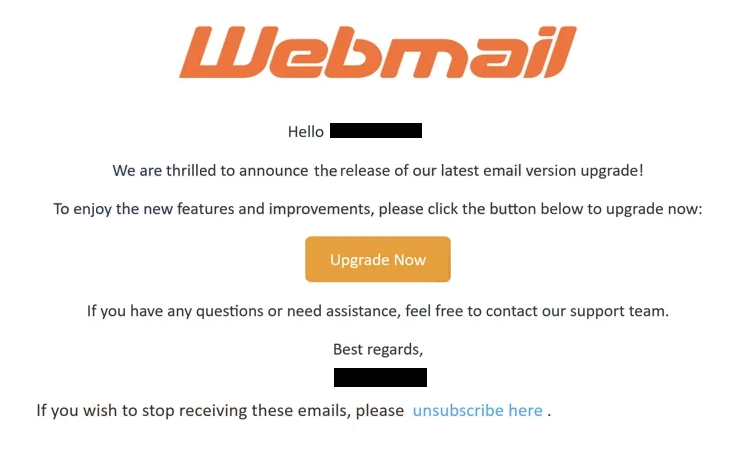The “Webmail – Email Version Upgrade” email is part of a phishing campaign that aims to steal users’ Webmail login credentials. The email claims that Webmail has been upgraded and asks that users upgrade their accounts as well to enjoy the new features and improvements. The button provided in the email leads to a phishing site, and users who type in their email login credentials will end up with their accounts hijacked.
The email “Webmail – Email Version Upgrade” is a typical phishing attempt that users should be quick to identify if they’re familiar with what phishing emails look like. It misleadingly states that Webmail has undergone an upgrade, requiring users to upgrade their accounts as well. This will supposedly allow users to enjoy the new features and improvements.
Included in the email is an “Upgrade Now” button. If clicked, this button takes users to a phishing website designed to closely mimic the legitimate Webmail site. Although the layout may look more or less identical, the URL will be distinctly different, which is a clear sign of a phishing site if users pay attention.
Entering login credentials on this fake site will send that information directly to the cybercriminals behind the phishing campaign. Email login details are particularly valuable to these criminals, as most users have longstanding email accounts filled with personal information, including receipts and private messages. Such access can lead to deeper intrusions into users’ lives and allow criminals to gather data for further targeting. Moreover, email accounts are often linked to various other accounts, so compromising an email account can lead to unauthorized access to other connected services. It’s essential for users to be extremely careful with their email login information.
The full text from the “Webmail – Email Version Upgrade” phishing email is below:
Subject: ******** Account Update
Webmail
Hello ********,
We are thrilled to announce the release of our latest email version upgrade!
To enjoy the new features and improvements, please click the button below to upgrade now:
Upgrade Now
If you have any questions or need assistance, feel free to contact our support team.
Best regards,
********If you wish to stop receiving these emails, please unsubscribe here .
How to identify a phishing email
Phishing campaigns are typically quite generic and target a large number of users with the same emails. However, some can be more sophisticated and harder to detect, though they’re often reserved for specific and high-profile individuals. Fortunately, the majority of users will likely encounter generic phishing emails that are relatively easy to identify.
Malicious actors often try to mimic legitimate companies in their phishing emails. For instance, an email titled “Webmail – Email Version Upgrade” may seem like it’s coming from your email provider, Webmail. However, it will not resemble any standard email that Webmail would actually send. Users also don’t need to “upgrade” their accounts whenever email service providers update their products.
One important detail to pay attention to is how the email addresses you. Legitimate companies usually greet you by your name when contacting you, rather than using a username. This personalized approach adds a layer of authenticity. In contrast, phishing emails often resort to generic terms like “Customer,” “Member,” or “User,” or may refer to you by your username, as is the case with the “Webmail – Email Version Upgrade” example. A legitimate email provider would know how to address you correctly.
Moreover, keep an eye out for grammar and spelling mistakes in emails, as they are usually very obvious in generic phishing emails. Legitimate companies take care to avoid such mistakes in their emails, particularly in automated messages, whereas phishing emails often contain numerous mistakes.
Phishing emails frequently claim that there is a problem with your account and pressure you to click on the provided links. This tactic is quite common, as demonstrated by the “Webmail – Email Version Upgrade” phishing email. Instead of clicking any links, it’s much safer to log in to your account manually to check whether there are actual issues. Always take this precaution, regardless of how legitimate the email seems.
Lastly, before logging in anywhere, double-check the site’s URL. Phishing websites are designed to closely resemble legitimate ones, but the URL always reveals a phishing attempt. If a URL looks suspicious in any way, do not enter your login details.
How to remove “Webmail – Email Version Upgrade” phishing email
You can remove “Webmail – Email Version Upgrade” if it lands in your inbox. If you have clicked on any links and entered your login credentials, you need to immediately change your email password. If you cannot access your email account, contact your email provider to see whether they can help you recover it. If account recovery is not possible, you need to disconnect your email from any linked accounts immediately to prevent those accounts from being compromised as well by malicious actors.
Site Disclaimer
2-remove-virus.com is not sponsored, owned, affiliated, or linked to malware developers or distributors that are referenced in this article. The article does not promote or endorse any type of malware. We aim at providing useful information that will help computer users to detect and eliminate the unwanted malicious programs from their computers. This can be done manually by following the instructions presented in the article or automatically by implementing the suggested anti-malware tools.
The article is only meant to be used for educational purposes. If you follow the instructions given in the article, you agree to be contracted by the disclaimer. We do not guarantee that the artcile will present you with a solution that removes the malign threats completely. Malware changes constantly, which is why, in some cases, it may be difficult to clean the computer fully by using only the manual removal instructions.
